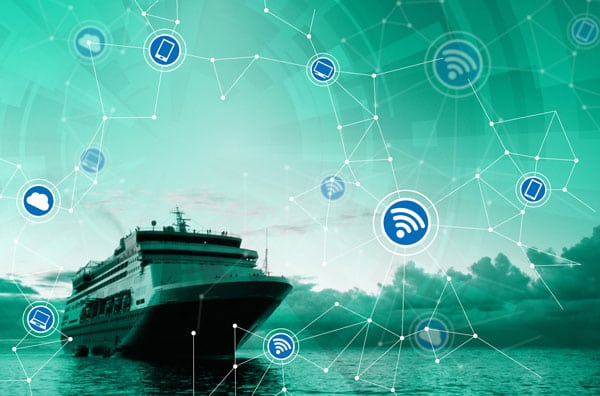Latest News

Photo: Via Satellite
The past year will be known as a year of strife and great difficulty for the maritime satellite communication market, as a number of key applications have been greatly affected by the restrictions of the COVID-19 pandemic. In Valour Consultancy’s H1 2020 Maritime Connectivity report, we highlighted how the trade sanctions between the United States and the Republic of China badly affected world trade. The current and prolonged effects of COVID-19 have, and will continue to be much worse. However, the pandemic has also highlighted the need for technologies that will provide the “green shoots” of recovery in the digitalization and communications realm of commercial maritime.
Reflections on 2020
The L-band market is believed to have been quite resilient to the troubles of 2020, with estimated global revenues in 2020 assumed to have declined by $25 million from 2019, and the number of vessels using L-band technology decreasing by 2,680 in the same period. Inmarsat, the biggest maritime L-band provider, no longer discloses its financial figures since it was purchased. However, it’s FleetBroadband business is expected to have only slightly reduced from 2019.
Iridium, like many companies, has only released its Third Quarter (Q3) 2020 financial results at this point. But Iridium’s commercial voice and data service (maritime forms part of this segmentation) revenues were down by $3 million for the first nine months of 2020, compared to the same period in 2019. Furthermore, the majority of this drop is attributed to the aviation rather maritime operations, as stated in the financial report. Its broadband revenues were actually up $4 million, and Internet of Things (IoT) data revenues flat for the same first nine months of 2020 versus 2019.
Delving into the Very Small Aperture Terminal (VSAT) market, Valour Consultancy estimates the retail market, the total value of airtime sold directly to the end user, dropped to $1 billion in 2020, a decline from $1.15 billion in 2019.
The passenger market, in particular sea cruises, has come to a complete standstill. The number of active VSAT connected passenger vessels have fallen from nearly 4,100 in 2019, to less than 700 in 2020. Although this is a dramatic market fall, the key question is what portion of service fees for satellite connectivity will redundant vessels have to pay — full, partial, or none?
The answer is yes and no.
From a wholesale perspective, large batches of capacity and bandwidth are agreed and contractual obligations for payment are scheduled years in advance. As such, even though demand for connectivity has reduced due to vessels being docked, service providers will nonetheless still need to pay for these services. The key questions are whether the end users will pay the service providers, or deferred? One could see how working in Inmarsat or Marlink’s accounts receivable team could be challenging.
Service providers offering customers flexible payment term contracts would have brought in only a fraction of their 2019 revenues if customers are not contractually obliged to pay for redundant vessels. As we understand it, most merchant vendors will have to pay 80% of their monthly contracted ARPU if not in use. With passenger cruise vessels, it’s uncertain whether they will pay the full ARPU per vessel in their service level agreements. My guess is yes — but smart connectivity providers may opt to tie their customers down to longer contract terms if customers are unable to pay current bills.
Offshore energy has also been badly hit, and Valour Consultancy anticipates 2,500 vessels/assets were made redundant in 2020. However, companies in this application are much more astute at catering to this in their service level agreements and have clauses for reduced service payments during periods of downtime.
The challenge with articulating how revenues are affected within the industry depends on multiple factors, such as wholesale or retail provider of connectivity services. Our gut feeling is maritime wholesale satellite revenues were flat to slightly up in 2020, compared to 2019; however, service provider retail revenues (to the end user) were possibly down by between 10-15%.
Revenues generated from 2020 VSAT Ku- and C-band equipped vessel market are predicted to decline by 19% and 17% from 2019’s standings, respectively. With the number of active vessels using the Ku- and C-band systems are also anticipated to decline between minus 11% and 5% over the same period.
Interestingly, Inmarsat has reported an increase in its FX fleet and as such, we have noted an increase in Ka-band equipped vessels, standing around an estimated 10,000 ships by the end of 2020. The company no longer reports its financial results; however, Valour Consultancy believes the firm has increased its FX vessel count by 10% and reflected this in the global Ka-band commercial revenues, thought to be around $255 million by the end of 2020.
The Next 12 Months
In the long term, vessel numbers with VSAT connectivity are expected to increase to nearly 66,000 by the end of 2029, and we project to see maritime VSAT revenues return to the same levels as 2019. The take up of VSAT services for broadband connectivity, combined with a decline of L-band connected vessels, will still remain the primary driver of the market going forward. A notable milestone is retail VSAT and Mobile Satellite Service (MSS) maritime services surpassing $2 billion by the end of 2025.
A Bright Spot in Smart Shipping
Despite the downturn of maritime connectivity services in 2020, one technology segment within the market has grown and will continue growing for many years: maritime digital applications and smart shipping technologies.
There is a realization that maritime digital applications and smart shipping technologies have come to the forefront of the industry. With the restricted movement of crew, depressed freight rates due to limited demand, and closed facilities, monitoring and managing assets without human interaction is crucial. The largest penetration of smart shipping technologies is within the passenger and offshore energy markets. However, we actually see the biggest untapped potential within the merchant sector. Container vessels, tankers, and bulk carriers are all prime targets for these solutions. Valour Consultancy estimates smart shipping solutions sold to merchant market amounted to $139 million in 2019 and will almost quadruple by the end of the decade.
Valour Consultancy foresees the current pick up of the merchant market as a positive sign for smart shipping and maritime IoT services. With the operational headaches and inability to perform key functions at sea, shipping companies will likely invest heavily in remote monitoring, optimizations, and control.
 Joshua Flood is a senior research consultant at Valour Consultancy. He runs the maritime research division which encompasses an array of reports examining connectivity and smart shipping technologies within the industry.
Joshua Flood is a senior research consultant at Valour Consultancy. He runs the maritime research division which encompasses an array of reports examining connectivity and smart shipping technologies within the industry.
Stay connected and get ahead with the leading source of industry intel!
Subscribe Now